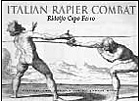 Ridolfo Capo Ferro was among the most important masters of the
Italian rapier. His treatise Gran Simulacro dell’arte e dell’uso della Scherma
is one of the most comprehensive and concise books on the art and
science of fencing ever written.
Capo Ferro’s date of birth is unknown. The portrait in his treatise
states ‘Ridolfo Capoferro in the 52nd year of age’, which indicates he
was born no later than 1558. An author’s portrait was often prepared
years before the book was published, so he was most likely born before
1558. There is some speculation that he was German, but there are two
reasons why this cannot be true. First, he clearly denotes on the title
page of his book that he was born in the Italian city of Cagli. Second, in
Chapter One of his book he says ‘noi Italiani’, which translates as ‘we
Italians’.
Ridolfo Capo Ferro was among the most important masters of the
Italian rapier. His treatise Gran Simulacro dell’arte e dell’uso della Scherma
is one of the most comprehensive and concise books on the art and
science of fencing ever written.
Capo Ferro’s date of birth is unknown. The portrait in his treatise
states ‘Ridolfo Capoferro in the 52nd year of age’, which indicates he
was born no later than 1558. An author’s portrait was often prepared
years before the book was published, so he was most likely born before
1558. There is some speculation that he was German, but there are two
reasons why this cannot be true. First, he clearly denotes on the title
page of his book that he was born in the Italian city of Cagli. Second, in
Chapter One of his book he says ‘noi Italiani’, which translates as ‘we
Italians’.
The misapprehension that Capo Ferro was German appears to stem from his use of the term ‘Alemanna’ on the title page of his treatise, which is often translated as ‘Germany’. There are two possible explanations for the use of this term. The most probable reason is that when moving to a foreign city people of the same ethnicity would frequently settle in a specific area of the town. This tradition continues today; many cities still have a Chinatown or a Little Italy. It is quite likely that when Capo Ferro said he was the master of the ‘most excellent German nation in the city of Siena’, he was referring to the German section of Siena.
The other, less substantiated theory is that he was referring to the fact that in 1610 Siena was a part of the Holy Roman Empire, which included what is now known as Germany, Austria, Switzerland, the Netherlands, Belgium and parts of France and Italy. The term ‘Alemanna’ could have referred to the Empire or a specific part of the Empire. Capo Ferro was one of the many fencing-masters who operated within its political boundaries. It is possible that he was referring to his status as a master in the Empire, but highly unlikely that he considered himself the ‘Master of the Empire’.
Unfortunately, there is very little known about Capo Ferro’s life. By the beginning of the 1600s he had moved to Siena. Gran Simulacro was published in 1610, but it was clearly finished a year earlier because one of the imprimaturs is from 1609. The treatise included forty-three plates of illustrations by Raffaello Schiamirossi, and it taught the use of single rapier, rapier and dagger, rapier and cloak, as well as rapier and rotella (a large shield).
Gran Simulacro became an important resource for Italian swordplay and was very popular in Europe. It was reprinted in 1629 with some slight alterations. There were small modifications to the text, but the main difference was that a new artist added allegorical scenes to the backgrounds of eight of the original images. In 1632, a smaller book was created by Bernardino Capilelli. This edition excludes the first half of Gran Simulacro. The text relating to the illustrations is truncated so that the explanation of each plate fits on one page. This edition includes all forty-three plates, but the original renderings are crudely redrawn and reduced to half-size.
Gran Simulacro was republished and imitated for centuries after Capo Ferro’s death. The work was held in the highest regard by swordsmen throughout the ages. Today, the most important scholars in the field consider it the pinnacle of treatises written on the Italian rapier.
Back to Greenhill Military Book News No. 129 Table of Contents
Back to Greenhill Military Book News List of Issues
Back to Master Magazine List
© Copyright 2004 by Greenhill Books
This article appears in MagWeb.com (Magazine Web) on the Internet World Wide Web.
Other articles from military history and related magazines are available at http://www.magweb.com